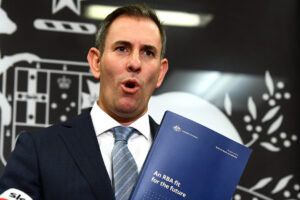Cost of living rose by more than inflation because of interest rate rises. Another rate rise would only cause more unnecessary pain.
In the past week, the likelihood of the Reserve Bank raising the cash rate to 4.35% has gone from about 20% prior to last week’s inflation figures coming out, to now an even-money bet.
But when you look at the cost of living figures out this week it is clear that households are already having to reduce their spending on non-discretionary items.
Out of the 14 biggest contributors to inflation, 10 were non-discretionary items.
At this point we should note the comments of the secretary of the Treasury, Steven Kennedy, last week in Senate estimates. He was asked about the pathway to a “soft landing” – ie where inflation falls without us going into a recession.
He noted that chances of a soft landing were made harder by recent rises in oil prices because “on the one hand, it will increase headline inflation by raising petrol prices. On the other hand, it may well reduce growth and see other prices fall because people have less to spend. At least in the short term, expenditure on petrol is not very discretionary.”
When the prices of things you can’t avoid paying for rise faster than others, then that obviously reduces your ability to spend elsewhere. In this way petrol, electricity and rental price rises have the same impact as do interest rate rises.
The most recent figures of the volume of retail spending will come out tomorrow, but we know that the volume has been falling, and is now back to pre-pandemic trend levels:
This of course is what you would expect – when the cost of non-retail items such as petrol, mortgages, rents, electricity, property rates, medical services and insurance are rising, you are going to buy less in the shops.
Since March last year the cost of mortgages has gone up 114%. Does the Reserve Bank think households haven’t really noticed that?
Even you if discount the record low rates during the pandemic, the cost of mortgages is now about 70% higher than it was at the end of 2019. Since then, wages have risen only about 10.5%.
Another rate rise is not going to do anything other than add to the cost of necessities. It would not so much reduce inflation as increase the cost of living and hit households whose wages and incomes continue to be worth less than they were a year ago.
Between the Lines Newsletter
The biggest stories and the best analysis from the team at the Australia Institute, delivered to your inbox every fortnight.
You might also like
Chalmers is right, the RBA has smashed the economy
In recent weeks the Treasurer Jim Chalmers has been criticised by the opposition and some conservative economists for pointing out that the 13 interest rate increases have slowed Australia’s economy. But the data shows he is right.
Another hold likely. So, what was the point of the RBA review?
Will the RBA cut interest rates tomorrow? Probably not. It’s Groundhog Day and they’re locked into repeatedly making to same mistake over and over again. A mistake that the recent RBA review criticised them for making just before the pandemic.
Corporate profits increase inflation | Fact Sheet
The prices of many goods and services have increased dramatically across Australia since 2021. This has resulted in hardship for many households—along with $100 billion in increased profits for major companies. These corporate profits have been a key factor driving inflation.




